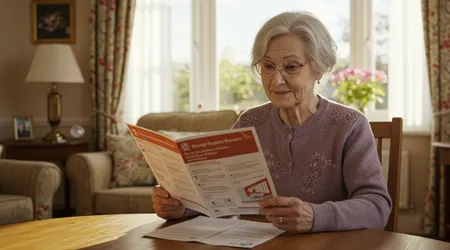Who Qualifies for the New Energy Support Scheme in the UK?

Who qualifies for the new energy support scheme in the UK? As energy prices remain a pressing concern, the UK government’s 2025 Warm Home Discount expansion offers relief to millions struggling with winter bills.
With energy costs 42% higher than in 2021/22, according to a House of Commons briefing, this scheme is a lifeline for vulnerable households.
This article dives into the eligibility criteria, recent changes, and practical steps to access this £150 energy bill rebate, ensuring you stay informed and warm this winter.
The Warm Home Discount, a cornerstone of the UK’s energy support framework, now reaches 6 million households, including 2.7 million newly eligible ones.
This expansion reflects a shift toward broader, more inclusive support, removing restrictive barriers like the high-cost-to-heat threshold. But what does this mean for you?
Whether you’re a pensioner, a low-income family, or someone navigating benefits, understanding who qualifies for the new energy support scheme is key to securing this vital aid.
This blog post unpacks the scheme’s eligibility, application process, and broader implications, blending practical advice with critical insights.
From real-world examples to a clear breakdown of qualifying benefits, we’ll guide you through the maze of energy support. Let’s explore how this initiative reshapes household finances and what it signals about the UK’s approach to energy equity.
Understanding the Warm Home Discount Scheme
The Warm Home Discount delivers a one-off £150 credit to eligible households’ electricity bills. Who qualifies for the new energy support scheme?
Primarily, those on means-tested benefits or Pension Credit. This winter, 6 million households will benefit, a significant jump from previous years. The scheme runs from October 2025 to March 2026, easing financial strain during colder months.
Unlike past iterations, the 2025 scheme scraps the high-cost-to-heat requirement. Previously, eligibility hinged on specific energy cost metrics, excluding many in need.
Now, if you or your partner receive qualifying benefits and are named on the bill, you’re likely eligible. This change reflects a pragmatic response to rising energy costs and public pressure for inclusive support.
Why does this matter? Energy poverty affects health and well-being, particularly for vulnerable groups. By broadening eligibility, the government acknowledges that financial hardship isn’t confined to specific housing types.
This shift, however, raises questions about funding sustainability and whether it fully addresses the root causes of energy inequity.
The scheme operates through participating energy suppliers, with 27 currently enrolled, including major names like British Gas and EDF.
++ How the Cost of Living Payments Are Changing This Year
If you’re with a smaller supplier, check their participation status on GOV.UK. Automatic eligibility applies for most, but some may need to confirm details with their supplier, especially in Scotland’s broader group.
Consider Sarah, a single mother in Manchester on Universal Credit. Previously ineligible due to her home’s energy efficiency, she now qualifies automatically, saving £150.
This practical relief helps her budget for essentials, highlighting the scheme’s real-world impact. Yet, gaps remain those on non-means-tested benefits may still struggle.

Eligibility Criteria: Who Qualifies for the New Energy Support Scheme?
Eligibility for the Warm Home Discount hinges on receiving specific benefits. Who qualifies for the new energy support scheme?
Households where the billholder or their partner receives means-tested benefits like Universal Credit, Income Support, or Tax Credits. Pension Credit Guarantee Credit recipients also qualify automatically.
The table below outlines key qualifying benefits for 2025:
| Benefit | Eligibility Details |
|---|---|
| Universal Credit | Must be named on the energy bill |
| Income Support | Includes those with disability or pensioner premiums |
| Pension Credit (Guarantee) | Automatic eligibility, no application needed |
| Working Tax Credit | Low-income households with specific criteria |
| Child Tax Credit | Based on income thresholds |
| Housing Benefit | Must align with low-income criteria |
This expansion, announced on 18 June 2025, removes the high-cost-to-heat barrier, making the scheme more accessible.
In Scotland, additional supplier-specific criteria may apply, so contacting your provider is crucial. The government estimates 900,000 families with children will benefit, a nod to tackling child poverty.
Take John, a pensioner in Glasgow receiving Pension Credit. His £150 discount arrives automatically, credited to his electricity bill by February.
Also read: Universal Credit 2025: What’s New in the Latest Update
This predictability allows him to plan heating costs without stress. Yet, critics argue the scheme overlooks those just above the low-income threshold, who face similar financial pressures.
A lingering question: is a one-off £150 payment enough when energy bills remain 42% higher than four years ago? While welcome, it’s a temporary fix.
The scheme’s expansion is a step forward, but long-term solutions like energy efficiency upgrades are equally critical for sustainable relief.
How to Access the Warm Home Discount
Securing the £150 discount is straightforward for most. Who qualifies for the new energy support scheme automatically?
Those on Pension Credit or means-tested benefits, identified by the government around August 2025. Your supplier applies the credit directly between October and March.
If you’re not automatically enrolled, check eligibility on GOV.UK or contact your supplier. Prepayment meter users may receive vouchers instead.
In Scotland, broader group applicants might need to apply manually, depending on the supplier. Always ensure your name is on the bill to avoid delays.
Read more: Jobseeker’s Allowance in 2025: Eligibility and Payment Rates
Missed last year’s discount? Contact your supplier before 31 March 2026 to claim retroactively. Acting early prevents missed opportunities.
For instance, delays in updating benefit status can exclude eligible households, so keep your details current with both supplier and DWP.
The process isn’t flawless. Some households, particularly those with complex benefit arrangements, face bureaucratic hurdles.
Energy UK’s Dhara Vyas noted the need for “accelerated progress on targeted support” to streamline access. Simplifying applications could ensure no one slips through the cracks.
Imagine a relay race: the baton of support must pass smoothly from government to suppliers to households.
Any fumble like outdated records disrupts the race. Proactive communication with your supplier is your best bet to stay in the game and secure your discount.
Broader Implications of the Scheme’s Expansion
The Warm Home Discount’s expansion signals a shift in energy policy. Who qualifies for the new energy support scheme now includes 2.7 million more households, reflecting a commitment to equity.
This aligns with the £13.2bn Warm Homes Plan, aimed at improving home energy efficiency.
However, critics highlight gaps. Those on non-means-tested benefits, like disability payments, often miss out despite high energy needs.
Debt charities argue for broader criteria to capture these vulnerable groups. The scheme’s reliance on suppliers also raises concerns about inconsistent application.
Energy prices, though expected to drop by £129 from July 2025, remain high. The Warm Home Discount offers relief but doesn’t address systemic issues like market volatility.
Long-term, investments in renewables and insulation, as outlined in the Clean Energy Industries Sector Plan, could stabilize costs.
The expansion also carries economic weight. Supporting 6 million households boosts local economies, as families redirect savings to essentials.
Yet, funding this £900m scheme strains public budgets, prompting debate about balancing immediate relief with structural reforms like the British Industry Supercharger.
What if we viewed energy support as an investment, not a handout?
By empowering households, the government fosters resilience, but only if paired with policies tackling root causes like inefficient housing. The Warm Home Discount is a start, not a cure.
Looking Ahead: The Future of Energy Support

As the Warm Home Discount expires in March 2026, its future is uncertain. Who qualifies for the new energy support scheme may evolve with upcoming announcements.
The government hints at a revamped scheme, potentially integrating with the Warm Homes Plan for deeper energy efficiency focus.
Emerging policies, like automatic compensation for billing issues, signal consumer-centric reforms.
Ofgem’s Energy Redress Scheme also channels funds to community energy projects, complementing direct support. These steps suggest a holistic approach to energy affordability.
Still, challenges loom. The Climate Change Committee’s 2025 report emphasizes that net-zero goals require scaled-up heat pump installations.
Without accessible grants, low-income households may lag in adopting these technologies, perpetuating energy inequity.
Public response will shape future policies. Engaging with consultations, like those for the British Industrial Competitiveness Scheme, ensures your voice counts.
Households must stay proactive, checking eligibility and advocating for inclusive reforms to bridge gaps in support.
Ultimately, energy support must balance immediate relief with long-term sustainability. Who qualifies for the new energy support scheme today may set the tone for tomorrow’s energy landscape, but only if policies evolve to meet diverse needs.
Conclusion: A Step Toward Energy Equity
The Warm Home Discount’s 2025 expansion is a vital lifeline, ensuring who qualifies for the new energy support scheme includes millions more.
With 6 million households set to receive £150, it’s a bold move to ease winter burdens. Yet, it’s a bandage on a deeper wound sky-high energy costs and inefficient homes demand systemic fixes.
This scheme empowers families like Sarah’s and John’s, but gaps persist for those just outside eligibility. As energy policy evolves, pairing discounts with efficiency upgrades could transform lives.
Stay informed, check your eligibility, and let’s push for a future where no one shivers through winter. Will you take the first step to secure your support?
Frequently Asked Questions
Q: How do I know if my supplier participates in the Warm Home Discount?
A: Check GOV.UK for the list of 27 participating suppliers, including British Gas and EDF. Contact your provider to confirm.
Q: What if I miss the automatic enrollment?
A: Verify eligibility on GOV.UK or contact your supplier by 31 March 2026. Update benefit details to avoid missing out.
Q: Can prepayment meter users get the discount?
A: Yes, you may receive a voucher by post or email. Contact your supplier to ensure proper delivery.
Q: What happens after March 2026?
A: The scheme’s future is under review. Watch for government announcements on extensions or new energy support initiatives.
